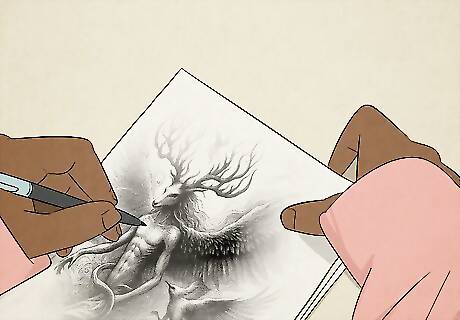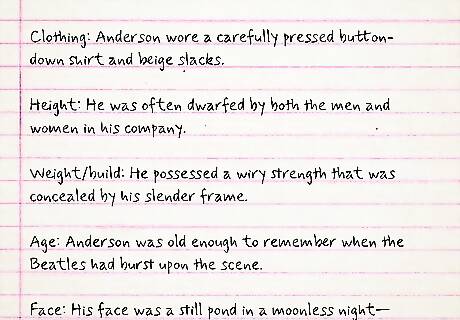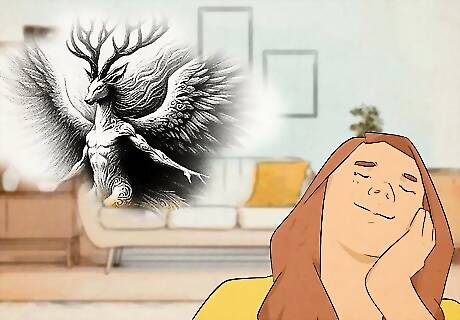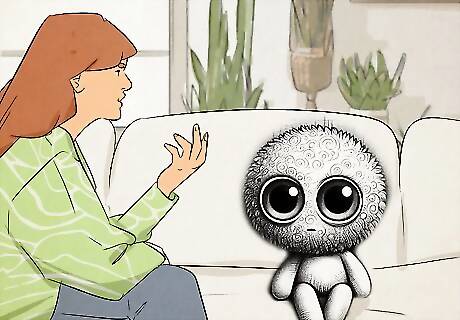
views
- Start by planning your tulpa’s appearance and personality. Sketch a picture of them or create a bulleted list of their physical and emotional traits, like hair or eye color.
- Close your eyes and visualize your tulpa in your imagination, picturing as much detail as possible. Imagine what your tulpa smells or feels like to make it more vivid.
- Imagine explaining the objects in your room to your tulpa to make it feel more real. Then, bring your tulpa on walks or interact with it regularly to fully realize it.
Creating Your Tulpa

Consider if creating a tulpa is right for you. Since tulpas are commonly described as their own sentient beings, some see them as permanent or independent creations. This means that, depending on how attached you get to your tulpa, you may not be able to dismiss them once they’re created, so be confident that you want to manifest a tulpa before you begin. In addition, some feel that dismissing a tulpa is comparable to abandoning a friend or family member, since they view tulpas as self-aware beings. Visit sites like Tulpa.info or watch YouTube videos about “tulpamancers” (people who have tulpas) to learn more about the practice. There are as many ways to have and interact with a tulpa as there are people!

Make your tulpa from scratch or base it on a character. To begin, decide whether you want to make an entirely new tulpa by mixing and matching aspects of its appearance or personality, or whether you want to manifest a character that already exists, like from a movie or a book. It’s sometimes easier to create a tulpa based off of a character, but the tulpa you create often deviates from that character in some ways—they might have a slightly different voice or appearance.

Sketch out your tulpa’s appearance to help you visualize them. If you’re creating a tulpa from scratch, it’s often easier to imagine and visualize them if you have a visual aid like a sketch or another image. Sit down and think about what you want your tulpa to look like, getting as specific as possible. Either make a loose sketch, or simply a bulleted list of their physical features. If you have trouble sketching or visualizing, use an avatar creation tool like Canva or even a videogame character creator to envision your tulpa. Your tulpa doesn’t have to be a humanoid—they can be an animal, a plant, even a sentient object. Some people warn against creating tulpas based on real people, as this might be seen as disrespectful to that person or an invasion of their privacy as an individual.

Describe your tulpa’s personality in writing. List as many personality traits you want your tulpa to have. Start with broad qualities, like “friendly” or “intelligent,” then get more specific, like, “enjoys dancing.” You don’t have to fully-realize your tulpa’s personality just yet. Many people with tulpas say that their tulpa evolved or “chose” their own personality as they spent more time thinking about them. Also ask yourself: What does my tulpa want? What motivates them? Giving your tulpa wants and needs makes it easier to think of them as their own being. In many ways, creating a tulpa is a lot like creating a fictional character, just that many people believe tulpas are much more real.
Visualizing Your Tulpa

Practice visualizing your tulpa’s form. Sit down and close your eyes, or begin to meditate. As you do, imagine your tulpa in your head; look at them from every possible angle you can think of. Try to visualize every detail of their appearance. Be patient, and take time visualizing them—this process can take up to a few hours. Envision them in your mind until you feel comfortable and confident that you can imagine or remember their appearance later. If you’re having trouble, improve your imagination by practicing visualizing simpler objects first, like a wooden chair, then move on to the tulpa once you feel more confident.

Imagine touching your tulpa. This is where your tulpa starts to really manifest. Many people call this stage “forcing,” as in forcing your tulpa into being. Imagine feeling the texture of their hair or their clothes, or imagine shaking their hand. Focus on one texture at a time, and spend 10-15 minutes on each, until you start to think of your tulpa as a physical presence. If it helps, touch your own hair or the fabric of your clothes while envisioning your tulpa’s textures to more completely imagine their physical form. Also, if you feel comfortable, imagine what your tulpa smells like. Having a trademark scent to associate them with can boost your imaginative power.

Visualize your tulpa's movements. Imagine how your tulpa moves and walks. Imagine them walking around your room, or doing a dance. Think about the gestures they use when they talk or emote—how do they move their hands when they’re happy or sad? Work on their expressions last. Try to imagine a conversation with them, and think about what their reactions and facial expressions would be. Always remember, each of these steps take time! Try not to rush it, and enjoy the creation process.

Imagine your tulpa in a particular setting. Some people find it easier to visualize their tulpa in a mental environment, where the tulpa can interact with its surroundings. These environments are called “wonderlands.” Think of a setting where your tulpa is most comfortable—for example, if your tulpa is an animal they might be comfortable in a forest. Imagine your tulpa moving about this place, jumping and sitting. Then imagine yourself in that place, too, interacting with your tulpa. Your wonderland is also a handy place to “leave” your tulpa if you get tired while creating it. Visit the mental wonderland later to resume the process.
Giving Your Tulpa Experiences

Start a basic conversation with your tulpa. The next step to creating your tulpa is giving them a voice of their own! Ask them questions, and imagine them answering in their own voice while moving their mouth, also known as “parroting.” Ask them what the weather’s like, or have them ask you how your day was. Talk to the them in your mind or out loud. It might feel a little awkward at first, but stick with it! Your tulpa might talk in your own voice at first, and you’ll probably have to think up their responses for them, but eventually you might find that their voice will become distinct and you won’t have to think as hard about their words.

Introduce your tulpa to the objects in your room. Now begin showing your tulpa the world around you. This is known as “narration,” and helps you envision your tulpa’s personality and how they react to stimuli, as a person does. To start, simply introduce your tulpa to objects in your room, explaining what they are and what they do, as though you were teaching a child. As you progress and start to think of your tulpa as a more independent being, imagine going on adventures with your tulpa in your wonderland. This helps you bond and form new experiences with them while you’re still manifesting them.

Visualize your tulpa throughout the day to make them feel more real. Go for a walk and have your tulpa accompany you. Or, have them help you with your chores or homework. Occasionally, hold your tulpa’s hand, hug them, or carry them on your shoulders. This helps you move your tulpa from your mind and into the real world. Also, practice envisioning your tulpa with your eyes open, which is known as “imposition,” or “imposing” your tulpa into the real world.

Keep interacting with your tulpa until it gets easier. Many believe that with practice and patience, you’ll reach a point where you don’t have to “puppet” your tulpa, and they’ll act on their own, instead, or even become sentient. Keep regularly imagining your tulpa as you go about your day, until you don’t have to think about how or why they would do something, and instead they just do it! Also, invite your tulpa into your memories by visualizing a door, and letting your tulpa walk through that door into a specific memory. This way, they get to know more about you, and your interactions will be more personal. Once your tulpa starts saying or doing things you might not expect them to, you’ve fully formed your tulpa! They’ll keep changing and evolving as time goes on, though, just like you do.


















Comments
0 comment